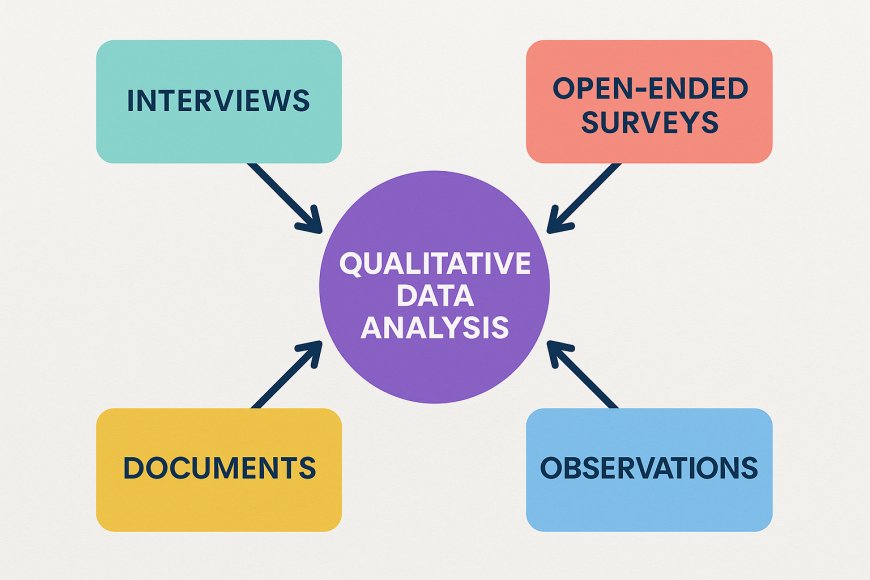Is Your Business Ignoring the Power of Qualitative Data Analysis
Discover how qualitative data analysis reveals the 'why' behind customer behavior, empowering smarter decisions, deeper insights, and stronger business outcomes.

In a time when businesses are inundated with metrics, charts, and dashboards, there's one form of insight many still overlook: human context. While numbers tell you what’s happening, they rarely tell you why. That’s where qualitative data analysis becomes invaluable. Understanding the stories, emotions, and motivations behind your audience’s behavior can unlock powerful growth opportunities and if your business isn’t paying attention, you may be missing out.
Understanding Qualitative Data Analysis
Qualitative data analysis refers to the process of interpreting non-numerical information such as interviews, open-ended survey responses, customer feedback, or behavioral observations to uncover patterns, meanings, and insights.
Unlike traditional data analytics, which rely heavily on numbers, this approach digs into thoughts, feelings, and language. It’s often the foundation of more customer-centric strategies, where decisions are informed not just by what people do, but how they feel while doing it.
This type of analysis is critical in domains like product development, branding, customer service, and employee engagement. When done right, it brings context to customer actions and reveals gaps that quantitative data might miss entirely.
Why Numbers Alone Aren’t Enough
It’s tempting for businesses to rely solely on quantitative metrics like bounce rates, sales conversions, or net promoter scores. These figures are easy to gather, track, and visualize. But while such data tells you what is happening, it doesn’t explain why.
For instance, imagine your website’s checkout abandonment rate is high. The number alone can’t reveal if users found the process confusing, lacked trust, or were frustrated by the payment experience. This is where data analysis in qualitative research fills the gap by exploring user feedback, voice recordings, or session transcripts, you can uncover the root cause and address it meaningfully.
Without this level of understanding, businesses risk making decisions based on assumptions, which can lead to wasted investments or missed opportunities.
Benefits of Embracing Qualitative Insights
1. Richer Customer Understanding
Qualitative data analysis helps decode emotions, motivations, and expectations. It provides insights into what drives consumer choices, what they value, and what frustrates them. This can influence everything from marketing messages to feature prioritization.
2. Better Decision Making
By combining personal stories with data trends, decision-makers can gain a holistic view. This leads to better prioritization and more effective strategies across marketing, operations, and customer experience.
3. Enhanced Product and Service Design
When you understand how users interact with your product on an emotional level, you can design more intuitive, satisfying solutions. Whether you’re launching a new app feature or revamping your onboarding process, insights from qualitative research analysis can guide impactful improvements.
Key Use Cases Across Business Functions
The power of qualitative insights stretches across departments:
-
Marketing teams use qualitative findings to craft emotionally resonant campaigns.
-
Product teams explore user feedback to improve functionality and usability.
-
Customer service departments analyze complaints and conversations to fine-tune support scripts and reduce friction.
-
HR and leadership rely on internal interviews to identify cultural strengths and challenges.
In each case, qualitative data gives voice to the people behind the numbers customers, employees, and stakeholders.
Common Techniques Used in Qualitative Analysis
Several techniques are used in data analysis in qualitative research, depending on the type of data and the desired outcome:
Thematic Analysis
This method involves identifying recurring themes or patterns across text-based data. For example, multiple users describing a product as “confusing” signals a usability issue.
Content Analysis
By quantifying the presence of certain words, phrases, or topics, businesses can measure emotional tone and focus areas of feedback.
Narrative Analysis
This method studies the way people tell stories, which is useful in brand perception or customer journey mapping.
Grounded Theory
Rather than starting with a hypothesis, grounded theory lets insights emerge organically from the data, ideal for exploratory research.
The application of these methods is often supported by qualitative research tools that help streamline the coding, tagging, and interpretation process, especially when handling large datasets.
The Role of Tools and Technology
Modern qualitative research tools have transformed how businesses handle this type of analysis. These platforms use features like natural language processing (NLP), transcription automation, and sentiment analysis to interpret large volumes of unstructured data efficiently.
This has made qualitative research more accessible even for smaller businesses that may not have dedicated research teams. With the right tools, gathering and analyzing meaningful feedback from customers or users is faster and more cost-effective than ever before.
Moreover, when paired with data visualization techniques, these insights can be communicated clearly across teams, helping organizations act on findings with greater confidence.
Combining Qualitative and Quantitative Data for Maximum Impact
Rather than choosing between qualitative and quantitative approaches, the most successful businesses combine them. Numbers validate the scale of a problem, while qualitative feedback explains the cause.
For example:
-
A customer satisfaction survey (quantitative) may show a score of 3 out of 5.
-
Follow-up comments (qualitative) reveal that long wait times and confusing instructions are the issue.
By integrating both forms of data, businesses create a feedback loop that’s both reliable and actionable.
This is where qualitative research analysis shines it doesn’t replace numbers but complements them, enriching your understanding and guiding smarter solutions.
Challenges and How to Address Them
Despite its value, some organizations hesitate to dive into qualitative research due to perceived challenges:
1. Time and Resource Constraints
Manual transcription and analysis can be time-consuming. However, adopting modern qualitative research tools can drastically reduce turnaround time.
2. Subjectivity in Interpretation
Unlike numerical data, qualitative data can be open to interpretation. To overcome this, use structured coding frameworks and involve multiple analysts to ensure objectivity.
3. Data Volume Management
Too much unstructured data can overwhelm teams. Filtering inputs based on relevance, using focused research questions, and leveraging AI-based tools can simplify the process.
Conclusion: It's Time to Listen Beyond the Numbers
Your business might be tracking customer behavior, sales performance, and campaign metrics but are you truly listening? Qualitative data analysis offers a powerful way to uncover what customers are thinking, feeling, and saying in their own words.
By embracing this approach, you move beyond surface-level insights and into the realm of human understanding. Whether it’s guiding product innovation, improving customer service, or aligning internal culture, the benefits are both measurable and meaningful.
Don’t let valuable feedback go unheard. Integrate data analysis in qualitative research into your decision-making process. Use reliable qualitative research tools to simplify the work. Apply structured qualitative research analysis to interpret results.
Because when you listen to the stories behind the numbers, your business becomes smarter, more empathetic, and far more effective.













































































































































